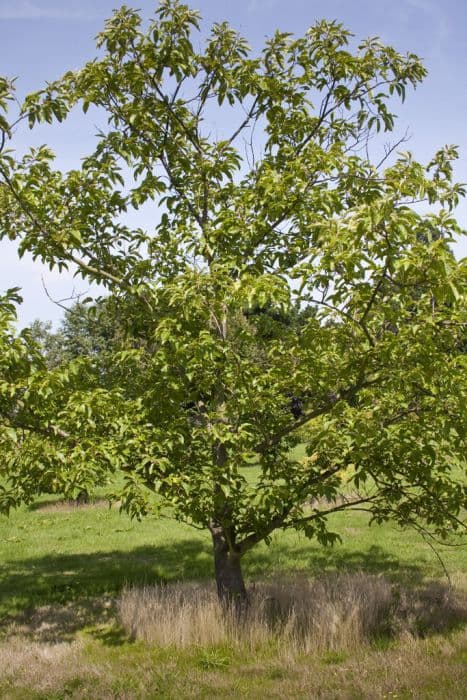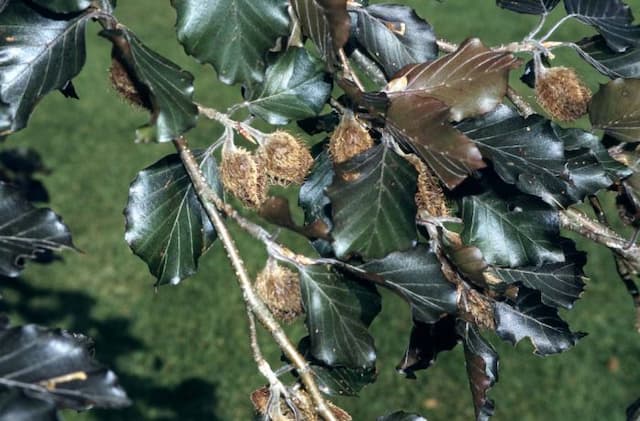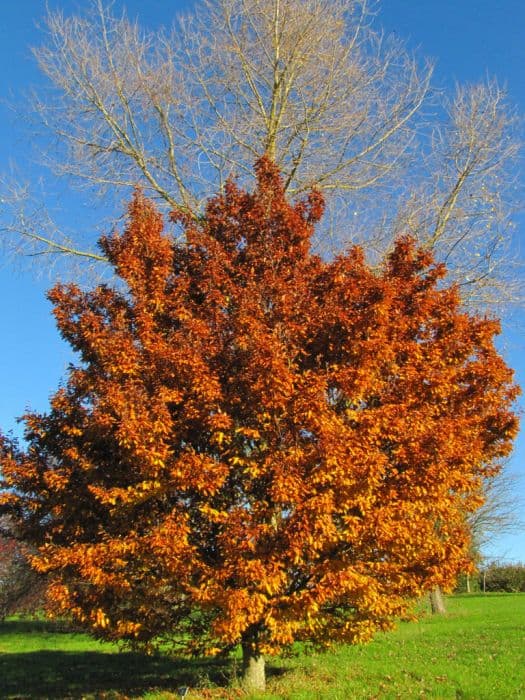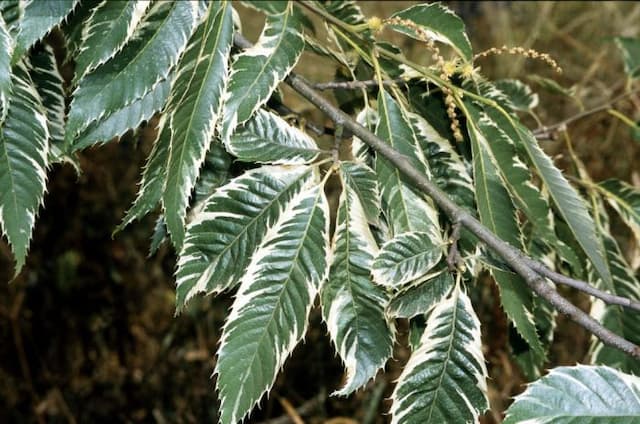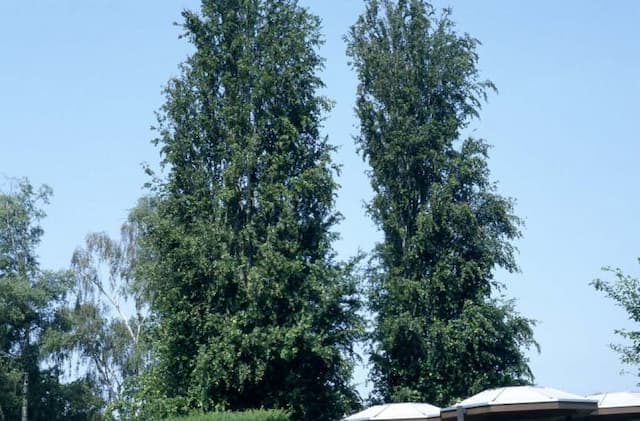Pin Oak Quercus palustris Green Pillar = 'Pringreen'

ABOUT
The Green Pillar Oak, known by its trade name 'Pringreen', boasts a distinctive and refined appearance. Its slender, columnar form is characterized by a narrow silhouette, making it an ideal choice for spaces where a more compact footprint is necessary. The branches of this oak grow upright and tight to the trunk, enhancing its vertical emphasis. Adorned with a rich canopy of deep green leaves, the Green Pillar Oak's foliage displays the classic lobed shape that is so often associated with oak trees. The leaf texture is glossy, which catches the light and adds a vibrant quality to its presence in the landscape. During the fall season, the leaves undergo a stunning transformation, presenting a breathtaking display of reds and oranges that add a warm, seasonal touch to the surroundings. As an oak, the Green Pillar is also recognized for its acorns, which are a quintessential trait of this group of trees. These acorns provide a source of food for wildlife and contribute to the overall ecological value of the plant. Overall, the appearance of the Green Pillar Oak 'Pringreen' is marked by its upright growth habit, lush green summer foliage, and striking fall coloration, all contributing to its popularity as a landscape choice.
About this plant
 Names
NamesFamily
Fagaceae.
Synonyms
Pin Oak, Swamp Spanish Oak.
Common names
Quercus palustris 'Pringreen'
 Toxicity
ToxicityTo humans
The Pin Oak is not commonly known as a toxic plant to humans. However, like many oak trees, its acorns and leaves can contain tannins, which can be harmful if consumed in large quantities, possibly causing stomach upset or kidney damage.
To pets
The Pin Oak, similar to other oak species, can be toxic to pets, particularly dogs and livestock. Ingesting large amounts of acorns or leaves, which contain tannins, can lead to symptoms such as vomiting, diarrhea, abdominal pain, and gastroenteritis. In severe cases, the tannins can cause kidney damage or even be fatal if a large amount is ingested and not treated promptly.
 Characteristics
CharacteristicsLife cycle
Perennials
Foliage type
Deciduous
Color of leaves
Green
Height
40 feet (12 meters)
Spread
10 feet (3 meters)
Plant type
Tree
Hardiness zones
5
Native area
North America
Benefits
 General Benefits
General Benefits- Aesthetic Appeal: Adds visual interest to landscapes with its narrow, columnar form and vibrant fall foliage.
- Shade Provider: Offers a cool respite on sunny days once mature.
- Wildlife Habitat: Supports birds and other wildlife through its acorns and structure.
- Erosion Control: With its extensive root system, it helps stabilize soil and prevent erosion.
- Drought Tolerance: Once established, it has a good tolerance for dry conditions, reducing the need for supplemental watering.
- Adaptability: Capable of growing in a variety of soil types, including wet soils.
- Low Maintenance: Requires minimal pruning and upkeep once established.
- Urban Tolerant: Can endure urban conditions like pollution and confined soil spaces.
- Longevity: Oaks are known for their long lifespan, providing benefits for generations.
- Seasonal Interest: Provides year-round interest with its changing leaf colors and winter silhouette.
 Medical Properties
Medical PropertiesThis plant is not used for medical purposes.
 Air-purifying Qualities
Air-purifying QualitiesThis plant is not specifically known for air purifying qualities.
 Other Uses
Other Uses- Woodworking: The wood of the Quercus palustris, commonly known as the Pin Oak, is often used in furniture making, cabinetry, and for interior finishes due to its strength and attractive grain.
- Landscape Design: Pin Oak 'Green Pillar' is used in formal garden designs for its columnar shape, providing height without taking up much horizontal space.
- Acorn Flour: The acorns of the Pin Oak, once leached to remove tannins, can be ground into flour for use in recipes as a gluten-free alternative.
- Dye Production: The bark of the Pin Oak can be used in the production of natural dyes for textiles, yielding different shades depending on the mordant used.
- Wildlife Habitat: Pin Oak 'Green Pillar' serves as a habitat for various wildlife species, including birds and small mammals, which use the tree for nesting and shelter.
- Soil Stabilization: Due to its deep rooting system, Pin Oak 'Green Pillar' is effective in preventing soil erosion, particularly along riverbanks or in areas of high wind exposure.
- Educational Tool: This particular cultivar of Pin Oak can be used in educational settings to demonstrate selective breeding and the development of plant cultivars for specific traits.
- Tannin Extraction: The bark and acorns contain tannins, which can be extracted and used as a natural preservative or in leather tanning processes.
- Photography Subject: Because of its unique form and beautiful fall foliage, the Pin Oak 'Green Pillar' is popular among photographers, especially for landscape and nature photography.
- Seasonal Celebrations: The leaves of Pin Oak 'Green Pillar' change color spectacularly in the fall, making it an excellent choice for autumn festivals and displays in temperate regions.
Interesting Facts
 Feng Shui
Feng ShuiThe Pin Oak is not used in Feng Shui practice.
 Plant Symbolism
Plant Symbolism- Strength: The common name for Quercus palustris 'Pringreen' is Pin Oak. Oaks, in general, symbolize strength due to their hard wood and enduring nature.
- Endurance: Pin Oaks can live for many years, which reflects the symbolic meaning of resilience and the ability to withstand challenges over time.
- Stability: The strong roots of the Pin Oak are often associated with grounding and stability, both in a physical and symbolic sense.
- Nobility: Traditionally, the oak is seen as the king of trees, thus associating it with nobility and honor.
 Water
WaterThe Pin Oak 'Green Pillar' should be watered deeply and thoroughly, receiving at least 1.5 gallons of water per week, particularly during the first growing season to establish a deep root system. After establishment, reduce frequency but maintain deep watering especially during dry spells. Increase waterings during prolonged periods of heat or drought to aid in preventing stress. Apply water directly to the root zone and avoid overhead watering to minimize foliar diseases. During the winter months, water less frequently but do not allow the roots to completely dry out.
 Light
LightThe Pin Oak 'Green Pillar' prefers full sunlight for optimal growth and health, requiring at least six hours of direct sun daily. Plant it in a location where it can receive unfiltered sunlight for most of the day, avoiding heavily shaded areas that can reduce its vigor and density.
 Temperature
TemperatureThe Pin Oak 'Green Pillar' thrives in a wide range of temperatures but performs best in temperatures between 60°F and 80°F. It is quite hardy and can withstand minimum temperatures down to about -20°F to -30°F, making it suitable for many climates. Always ensure the tree is not exposed to extreme hot or cold temperatures to avoid stress and damage.
 Pruning
PruningPrune the Pin Oak 'Green Pillar' during the late winter or early spring to remove dead or damaged branches and to shape the tree. Pruning while the tree is dormant helps prevent the spread of disease and encourages healthy new growth. Annual pruning is recommended to maintain tree structure and health.
 Cleaning
CleaningAs needed
 Soil
SoilThe best soil mix for the Pin Oak 'Green Pillar' should be well-draining, loamy soil with a slightly acidic pH between 5.5 and 7.0 to mimic its natural habitat preferences.
 Repotting
RepottingPin Oaks 'Green Pillar' are generally large trees and rarely, if ever, need repotting. As a landscape tree, it spends its life planted in a permanent outdoor location.
 Humidity & Misting
Humidity & MistingThe Pin Oak 'Green Pillar' tolerates a wide range of humidity conditions and does not have specific humidity requirements, as it is robust and adaptable to different outdoor climates.
 Suitable locations
Suitable locationsIndoor
Grow Pin Oak 'Green Pillar' indoors with ample space, bright light.
Outdoor
Plant in full sun, ensure space for root growth, and yearly pruning.
Hardiness zone
5-9 USDA
 Life cycle
Life cycleQuercus palustris, commonly known as the Pin Oak or Swamp Oak, begins its life as an acorn, which, after falling to the ground, goes through a period of dormancy during the colder months before germinating in the spring. Once germinated, a taproot is established with a shoot emerging above ground, developing into a sapling. The Pin Oak grows relatively quickly and will go through a juvenile stage where it focuses on increasing in height and width. As it matures, the tree develops its characteristic narrow, columnar form and starts to produce acorns once it reaches about 20 years of age. Each year thereafter, the Pin Oak continues to grow and produce acorns, with its reproductive phase peaking from age 50 to around 100 years. After its peak reproductive years, the tree enters its senescence stage, where growth slows and it gradually loses vitality, eventually succumbing to age, disease, or environmental factors.
 Propogation
PropogationPropogation time
Spring-Early Summer
Quercus palustris Green Pillar, commonly known as Pin Oak, is typically propagated by seed or occasionally by grafting. Since it is a cultivar, the most popular method of propagation to maintain its specific characteristics is through grafting. This process involves taking a scion, which is a piece of a branch with buds, from the Green Pillar and grafting it onto the rootstock of a different but closely related species. Grafting is best done in late winter or early spring before new growth begins. The scion is cut to have a diagonal edge and is then joined to a similarly cut surface on the rootstock. The two pieces are bound together, and the joint is sealed with grafting wax or tape to prevent dehydration and infection while the graft heals. This method ensures the new tree will display the true characteristics of the Green Pillar cultivar.
